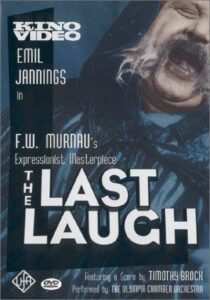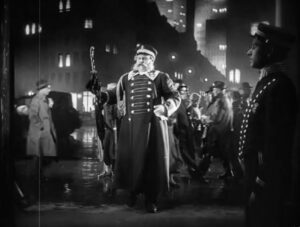“The Last Laugh” (1924) – the Power of Social Uniform

Title: “The Last Laugh” (“Der letzte Mann”)
Release Date: 1924
Director: Friedrich Wilhelm Murnau
Cast: Emil Jannings, Maly Delschaft, Emilie Kurz, Georg John, Hans Unterkircher
Friedrich Wilhelm Murnau’s films are undoubtedly outstanding achievements of the silent era of cinema. “The Last Laugh” is the best proof of that. This classic, nearly 100 years old, is still watched with genuine emotion, and the director’s reflection on man’s place in the community remains highly topical.
“The Last Laugh” comes from 1924. Murnau made the film during his Berlin period. The film is situated on the borderline of two styles characteristic of the German cinema of that time, namely expressionism and cammerspiel. The director combined an interest in the symbolic role of a prop or set design with a focus on ordinary human life. The main character of the film is the Porter, working at Berlin’s Hotel Atlantic. The man does his job with the utmost devotion, and his uniform commands the respect of all his neighbors.
One day, however, due to his advanced age, the young hotel manager strips him of his beloved job and demotes him to the role of a toilet attendant. This is a real drama for the proud Porter. For some time he tries to hide his new job by wearing a secretly stolen hotel dress. Unfortunately, the truth soon comes out and the old man becomes an object of merciless derision for the entire district. The man leaves his apartment in shame and spends the night in the toilet of the hotel. At this point in the story there is an intervention by the director in the form of information: “The story should end here. Nothing awaits the unhappy old man but death. However, the screenwriter took pity on him and added a completely improbable epilogue”. And here we see how the protagonist inherits half of the millionaire’s fortune, who dies in his arms while washing his hands.

“The Last Laugh” – the perfection of form in Murnau’s work
“The Last Laugh” went down in cinema history as a perfect achievement in the field of cinematic narrative. What we have here is a masterful use of the camera as a narrator following the course of the plot. The shots are extremely vivid – at times long, at others quick and nervous, depending on the prevailing mood. When the protagonist is overwhelmed by difficult experiences, the camera also “overwhelms” him and “looks down” on the man. When, on the other hand, the doorman proudly walks down the street, the camera captures him from below, being, as it were, a step below him.
Murnau has captured the atmosphere of the big city in an ingenious way, using dynamic camera movements that convey the rush and bustle of the metropolis. The shots of the hotel shot from the perspective of the revolving door are particularly successful. They also become a kind of symbol of the changing wheel of human fate. An important role is played by close-ups that convey the protagonist’s experiences without words, e.g. when he reads a job termination notice handed to him, the camera’s eye magnifies the most heartless phrases of the text. The same is true of the protagonist’s affront, when we see close-ups of malicious predatory smiles.
“The Last Laugh” – Expressionism and kammerspiel
In “The Last Laugh” we find typically expressionistic elements, such as the deformation of buildings and realistic shots, the play of shadows on walls, and especially the grotesque dream of the main character. Signs of the chamber style, on the other hand, are the focus on ordinary, everyday life and the peculiar fatalism of the characters’ fate. The almost complete abandonment of subtitles in the film is also a significant sign of the latter. Practically the whole story is told without words, only through the camera. This, combined with the lack of individual character traits (e.g. names and surnames), makes “Last Laugh” a work of universal significance.

“The Last Laugh” – a surprising happy ending
An interesting issue connected with Murnau’s film is the unexpected fairytale ending. This happy ending was forced upon the screenwriter, the famous Carl Mayer, by the producer Erich Pommer. Interestingly, this was also the reason why the director who was originally supposed to make “Last Laugh”, Lupu Pick, abandoned the project. Nevertheless, the film’s unnaturally happy ending has become a peculiar trademark of this work. It can be seen as an ironic commentary on Hollywood productions, but also as an eloquent emphasis on the contrast between the protagonist’s real situation and his illusory, impossible dreams.
“The Last Laugh” – the power of a social role
“The Last Laugh” is, above all, a penetrating film about the importance of the opinion of one’s native environment. In this context, it is worth noting the significant scenes with reflections – in the hotel’s revolving glass entrance door, in the door leading to the restroom, and in the mirrors. The mirror is one of the main symbols of the film, signaling the protagonist’s looking through other people’s eyes and building his own self-esteem on this basis. The central symbolic prop of the film is the uniform worn by the protagonist. It becomes a sign of one’s social role. Depriving the uniform results in the loss of respect from the environment. The individual qualities of the protagonist, such as goodness, helpfulness or diligence, cease to count. What is interesting, however, is that Murnau masterfully, precisely by means of the aforementioned happy ending, shows that social respect can only be aroused by authentic social status. The doorman in the role of a millionaire is unbelievable and, despite his wealth, evokes laughter from those around him. “The Last Laugh” is therefore an extremely deep and pessimistic reflection on the space of social relations.
Literature:
A. Grabicz, “Kino, wehikuł magiczny. Przewodnik osiągnięć filmu fabularnego. Podróż pierwsza 1913 – 1949”, Kraków 2007.
